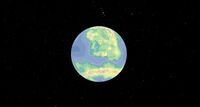Krystar
This article is incomplete because it is pending further input from participants, or it is a work-in-progress by one author. Please comment on this article's talk page to share your input, comments and questions. Note: To contribute to this article, you may need to seek help from the author(s) of this page. |
 View of Krystar from the Space | |||||||||||||
| Designations | |||||||||||||
|---|---|---|---|---|---|---|---|---|---|---|---|---|---|
| Pronunciation | /kɹaɪstɑr/ | ||||||||||||
| Earth and The World | |||||||||||||
| Orbital characteristics | |||||||||||||
| Epoch KS2000 | |||||||||||||
| Eccentricity | ~0.0167091 | ||||||||||||
| 365 d (12 months) | |||||||||||||
Average orbital speed | 29.782 km/s | ||||||||||||
| 358.618° | |||||||||||||
| Known satellites | 2 natural satelites: Kryptod and Crone | ||||||||||||
| Physical characteristics | |||||||||||||
| Mass | 11.994 × 10²⁴ kg | ||||||||||||
| 11.191 km/s | |||||||||||||
| 28.3° | |||||||||||||
| |||||||||||||
| Atmosphere | |||||||||||||
| Composition by volume | nitrogen (76%)
oxygen (23.36%) argon (0.6%) carbon dioxide (0.04%) | ||||||||||||
Krystar, also known as The Earth or The World, is the third planet in the Xyron System, between Aelion and Zephyria. It is the only explored planet in the system that has been found to be habitable. The Planet of Krystar has two satelite moons revolving around it, namely Kryptod and Crone. The Planet is divided into five continents geographically, which are surrounded by large waterbodies which include straits, seas and oceans. Krystar's atmospheric dynamics are pivotal in maintaining its surface conditions and safeguarding it against meteoroids and harmful UV radiation. Dominated by nitrogen and oxygen, Krystar's atmosphere also hosts abundant water vapor, forming expansive clouds that blanket its surface. Acting as a greenhouse gas, water vapor, in conjunction with other gases like carbon dioxide (CO2), regulates temperature by trapping solar energy, thus enabling the existence of liquid water and sustaining a habitable environment. This intricate interplay of gases underscores Krystar's ability to support life and maintain a stable climate, emphasizing the planet's significance within the cosmos. Understanding these atmospheric processes is essential for comprehending Krystar's unique environmental characteristics and its broader role in the universe.
Krystar, similar to most other bodies in the Xyron System, originated 4.5 billion years ago from gas and dust in the early Solar System. During the first billion years of its history, the ocean formed, and subsequently, life began to develop within it. Life eventually spread globally, altering Krystar's atmosphere and surface, culminating in the Great Oxidation Event two billion years ago. The Current Species of Homo sapiens emerged around the year 2100 BCE in Alagesia and have since dispersed across every continent on Krystar. Dependence on Krystar's biosphere and natural resources is crucial for human survival, yet their activities have increasingly impacted the planet's environment. Currently, humanity's influence on Krystar's climate and biosphere is unsustainable, posing threats to the livelihoods of humans and numerous other life forms, and causing widespread extinctions.